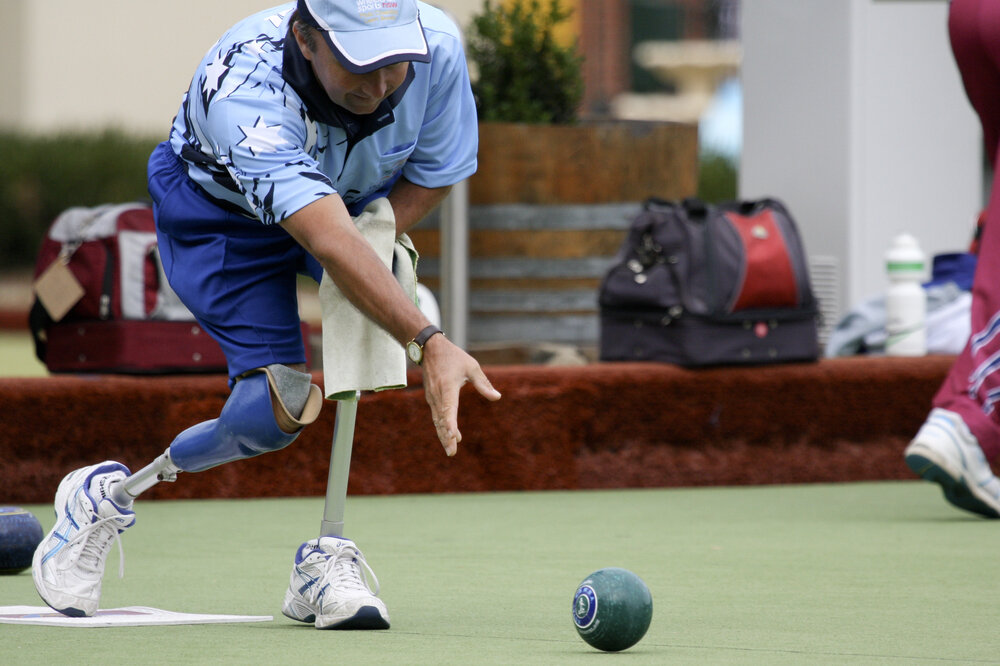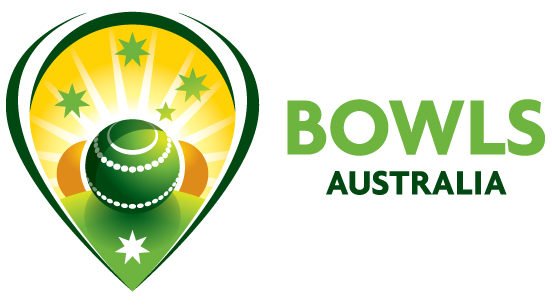Lawn Bowls
Introduction
Lawn Bowls is a low impact, precision sport where people with a physical disability can participate equally with able-bodied competitors. There are no changes to the standard competition rules of Bowls applied. The game involves rolling radially asymmetrical balls (called lawn bowls) towards the target of a smaller white ball (called the Jack).
Para-Sport Lawn Bowls was played in the 2014 Glasgow Commonwealth Games. The inclusion of Para-Sport Lawn Bowls in the Commonwealth Games helped mainstream the sport and integrate these athletes into able-bodied sports organizations.
The 2023 Para Nationals will be staged in Western Australia from October 6 - October 9, 2023.
How to PLAY LAWN BOWLS
Lawn bowls is played on a large, rectangular, manicured grass or synthetic surface known as a Bowling Green which is divided into parallel playing strips called rinks.
The aim of the game is to get one or more of your team's bowls closer to the Jack than your opponent's.
The game starts with a coin toss and the winner lays the mat and rolls the jack to the other end of the green to serve as a target. Once it has come to rest, the jack is aligned to the centre of the rink and players take turns to roll their bowls from the mat towards the jack and thereby build up the "head" (the cluster of bowls around the jack).
Bowls may curve outside the boundary of the rink, but must come to rest within the boundary to remain in play. Bowls falling into the ditch (at the end of the green) are dead and removed from play – with the exception of when one has made a connection with the jack (known as a “toucher”). "Touchers" are marked with chalk and remain alive in play even if they fall into the ditch.
Similarly, if the jack falls into the ditch it remains alive (unless it is beyond the side boundary), resulting in a "dead" end which is either replayed or replaced on a designated spot – depending on the rules of the competition. Once each competitor has delivered all bowls (two, three or four depending on the competition), the distance from the jack to the closest bowl(s) is determined, and one point (called "shots") is awarded for each competitor’s bowl which is closer than the opponent's closest bowl to the jack. For example, where a competitor has three bowls closer to the jack than their opponent’s, they are awarded three shots. The exercise is then repeated for the next end, across a designated number of ends.
Games can be singles (one player per team), pairs (two players per team), triples (three players per team) or fours (four players per team). In the Mixed Pairs each bowler also has a Director who advises the player of the location of the jack in relation to the mat, and the bowls in relation to the jack. As a result there are four players from each team on the green during the Mixed Pairs.
Player selection is done before the game and cannot be changed during play
Who can play LAWN BOWLS
Impairment Type
To be eligible to play Para-Sport Lawn bowls individuals must have a vision impairment or a physical disability that affects movement, usually due to birth defects, diseases, surgery or injury.
Classification
Each Lawn Bowls player is classified based on their disability. Athletes with a vision impairment undergo a vision test. Athletes with a physical impairment undergo a bench test and functional skills test. A bowler must have lost at least 10 points in testing to be eligible for classification. There are eight sections within the Lawn Bowls classification system and specific requirements are applied to the type of wheelchairs athletes can use. B1-B4 are classes of bowlers with a visual impairment. B5-B8 are classes for bowlers with cerebal palsy. A person is eligible for lawn bowls if they have lost at least 10 point on the
B1: Unable to recognise single tumbling E 100M at 25cm (LogMAR 2.6 is out)
- The STE is the task used to determine B2/B1 boundary
B2: Unable to recognise single tumbling E 25M at 1m (LogMAR 1.4 is out)
- The STE is the task used to determine the B3/B2 boundary and confirmed with LogMAR Acuity Chart (big)
B3: Unable to recognise the LogMAR 0.9 on the chart = 32M LogMAR chart at 4 metres (LogMAR 0.9 is out)
- LogMAR Acuity Chart is mandatory to determine ‘good VA’ border of the B3 range (boundary B3/B4)
B4: Able to recognise LogMAR 0.9 on the chart up to 0.6 LogMAR on the chart together with a field of vision of less than 20 deg in diameter (LogMAR 0.5 is out)
- LogMAR Acuity Chart is mandatory to determine VA borders of the B4 range (Boundary B4/NE)
B5: Wheelchair bowlers who can only use a very small bowl (size 00) due to limitation of upper limb function. Ambulant and wheelchair bowlers with restricted grip and upper body limb function, poor balance and co-ordination, unable to bowl a full length end or needing a splinting device to do so (Not including the bowling arm as used in Australia).
B6: Ambulant and wheelchair bowlers with reduced balance function (loss of 5 points or more) but able to bowl a full length end.
B7: Ambulant and wheelchair bowlers with minor balance problems (loss of less than 5 points).
B8: Ambulant bowlers, who have a permanent and irreversible disability, have lost 10 points on the bench test, but have no noticeable impairment of function.
How Do I Get Classified?
To determine a vision impaired athlete’s class, classifiers conduct a series of acuity and visual field sight tests.
To determine a physically impaired athlete’s class, classifiers observe athletes as they perform a range of movements. They test for muscle power, coordination and range of movement. They also measure the length of the athlete’s upper and lower limbs. The athlete is observed bowling balls, kicking back balls and walking the length of the green prior to game play and during game play, if necessary.
In order to be classified for Para-Sport lawn bowls you should first contact your State Territory Association (STA). For their contact details please see below. Each STA will organise a minimum of two Classification opportunities per year for athletes to be classified to a national level. Bowls Australia, as the NSO, then organise two International Classification opportunities per year. Classification is overseen and conducted by International Bowls for the Disabled.
Where can you participate?
AUSTRALIA
Ellen Falkner | Para Bowls High Performance Manager
Bowls Australia
P: +61 3 9480 7100
efalkner@bowls.com.au
STATE / TERRITORIES
New South Wales
Wheelchair Sports NSW/ACT
P: +61 2 9809 5260
https://www.wsnsw.org.au/disability-lawn-bowls/
Queensland
Bowls Queensland
P: +61 7 3354 0777
http://www.bowlsqld.org/
Victoria
Bowls Victoria
P: +61 3 9861 7100
https://www.bowlsvic.org.au/
Western Australia
Bowls WA
P: +61 8 9340 0804
https://www.bowlswa.com.au/
Tasmania
Bowls Tasmania
P: +61 3 6331 7436
http://bowlstasmania.com.au/
Northern Territory
Bowls NT
P: +61 409 463 061
http://bowlsnt.com.au/
Australian Capital Territory
Bowls ACT
P: +61 2 5105 1083
http://bowlsact.org.au/
South Australia
Bowls SA
P: +61 8 8234 7544
http://bowlssa.com.au/
Resources
Videos
Under the Scope Series - How to play from Bowls Australia
Documents
International Rules from International Bowls for the Disabled
Classifier Pathways from International Bowls for the Disabled
Lawn Bowls Sport Section Guidelines from Disability Sports Australia


